#alphabet pattern printing in java
Explore tagged Tumblr posts
Link
As a new book is published on African wax print textiles, Vogue speaks to its author about the complex origins and stories behind eight of the most vibrant prints. Once a craze confined to Africa’s Gold Coast; now, African wax prints have gone global. Take Beyoncé, who rocked the printed cotton fabric for her baby shower last year, asking her guests to wear African-centred gelées, kufis and wax-printed pieces. “It is everywhere but at the same time people don’t know really the story and the meanings of this textile,” says Anne Grosfilley, author of a new book, African Wax Print Textiles, published by Prestel this month (£45, available here). The book is a detailed exploration of the fabric’s origins, techniques and cultural currency as well as a showcase of vibrant, eye-popping designs. “There are colours you would not see in other types of textiles,” Grosfilley says, citing deep blue with orange. These are also clothes with deep meaning: often, fabrics have hidden messages. African wax prints actually came from the Netherlands. In the second half of the 19th century, fuelled by the industrial revolution and colonial expansion, new markets opened in the Dutch East Indies (now Indonesia) as well as Africa. With the Netherlands securing its presence in Java, its textile companies began competing with the local artisanal batik techniques, producing their own cotton prints. These Dutch wax prints, however, bombed as the Dutch dyes created cracks, so new markets had to be found. In 1893 the first Dutch wax prints landed in the African Gold Coast (now Ghana), where they became style and status symbols. During the 1950s, their appeal spread across west Africa, when the Mercedes-Benz driving female entrepreneurs (known as the Nana Benz) bought the fabrics into Togo and gave them names to add mystique. Africa’s fight for independence in the 1960s led to wax prints being made locally. More recently, cheap Chinese copies have made wax prints more accessible to the rest of the world. Now, wax prints are worn with denim and other Western styles with men donning the print too. Here, a selection of the most intriguing wax prints and the unusual stories and meanings behind them.
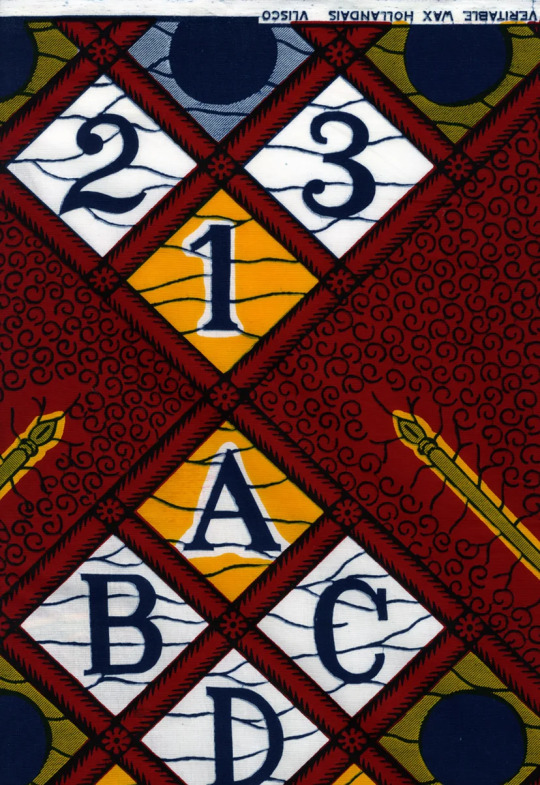
Alphabet, 1920
Created in 1920, this alphabet design was worn mainly by people who went to the colonial school, and could read, write and count with the new mathematics. “People were very proud of it and they would wear this wax print to say, 'look, I’m literate and an educated person’”, says Grosfilley. Today, the design still retains this symbolism, even used by political parties for propaganda, "as if to say, 'look, this is a good value design and I am a good value president, so you should support me because I am as good as education,’” she says. Modern motifs have updated the design with computers replacing blackboards.
© Original HKM Design, 1920. Holland, Netherlands © Vlisco Group
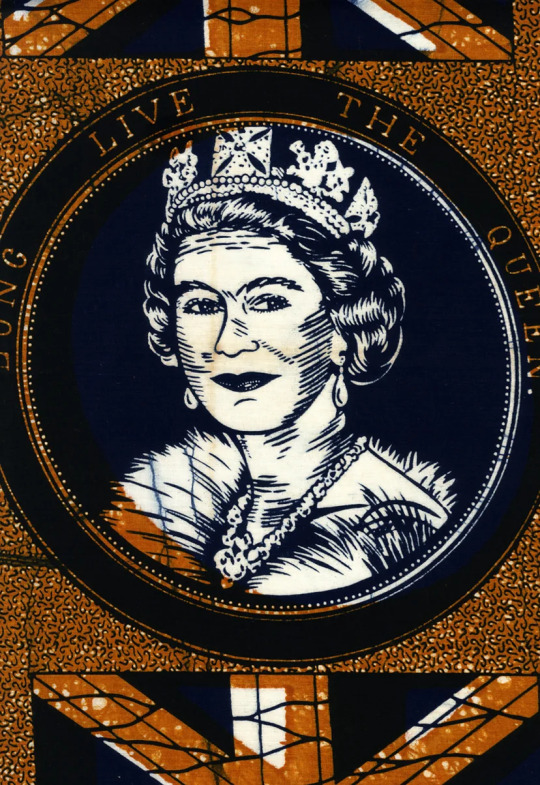
Elizabeth II, 1956
Designed for Queen Elizabeth II’s first visit to Nigeria in 1956, Grosfilley believes this wax print was given away to ensure a crowd gave her a warm welcome - as the visit was shortly before the country gained independence. It’s an African tradition for people to wear the same fabric for a specific occasion, whether it's close family and friends at a wedding, or at a political rally where the crowd wears a print with the president’s face, or to show solidarity with a group or community. "In Africa, we are less individualistic than in the western cultures,” argues Grosfilley, though explains that each person wears print in their own way. “So you are part of a group but at the same time you are unique." Don't miss the imperfections of the wax process that appear as cracks in her fur and the early wax print colours, brown and indigo, on the original white of the fabric.
© Elizabeth II, first visit to Nigeria in 1956. Elson & Neill Wax Print A13922 Flag and Crown, United Kingdom © Cha Textiles Ltd
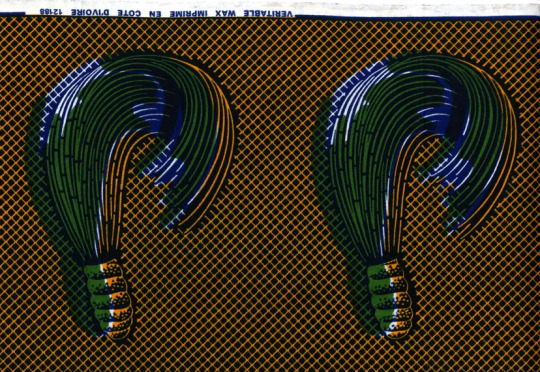
Fly-Whisk, 1950
A fly swatter may seem like an everyday symbol, but actually it symbolises power and prestige. Why? These are the brooms used to swat away the mosquitoes and other flies from the kings and traditional chiefs of the Akan people who live across the Ivory Coast and Ghana. Once wielding great economic power selling gold and ivory to the British and other countries, today these kings and chiefs are more symbolic. Designed in 1950, the pattern is set in big squares à la Adinkra, Adire and other African handmade textiles and has a decorative background to prevent any cracks caused by the batik process being seen.
© “Fly-Whisk” Vlisco 12188. 1950 © Vlisco Group
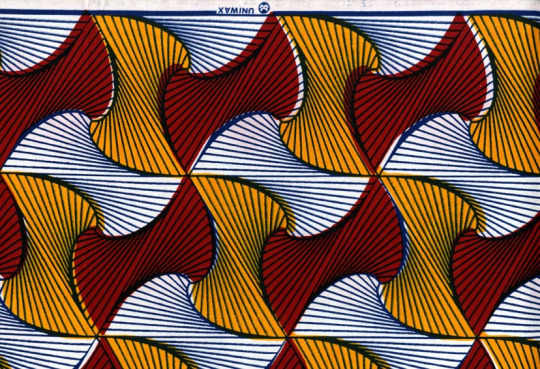
Darling, Don't Turn Your Back On Me, 1980s
This abstract pattern from the 1980s was inspired by paper used to wrap meat in a French butcher. According to Grosfilley: “This is the magic of wax print, as you see a design and you project something which may be completely different from the original meaning.” For women in Toga, it's known as, “darling, don’t turn your back on me,” when they think their man is not looking at them anymore, but another woman. “In real life, the men don’t understand or don’t care as they don’t pay attention to the meaning of wax print. So although the message is to the man, really it is to the other woman,” she says.
© Vlisco 11728, called “Darling, don’t turn your back on me” © Vlisco Group
[I am suddenly visualizing women wearing clothing with the boyfriend meme printed on it!]
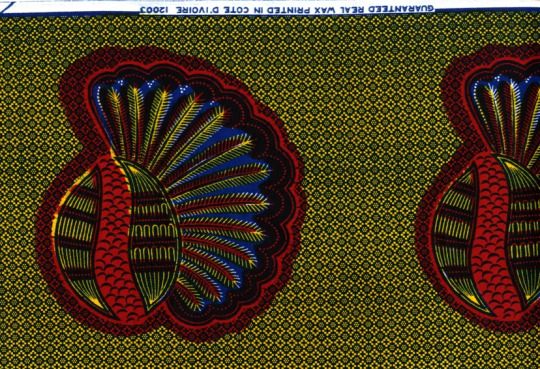
Shell
One of the earliest wax print designs, produced in Ivory Coast, this is now a classic. Depicting the wings of the Garuda bird, Indonesia’s national emblem, this print symbolises how Indonesian designs have been re-interpreted in Africa. Take the Ghanaians, who see the design as a bunch of bananas, as “it’s part of their basic food as you’d eat it as a fruit or in a stew,” says Grosfilley. Or the Togans, who call the print, “the snail coming out of its shell,” after the snails they eat (and local phrase meaning "busybody"). Wearing the design, according to Grosfilley, means that “you should look at your own business instead of looking at what other people are doing,” she says.
© Uniwax wax print 12003, Painted in Ivory Coast © Vlisco Group
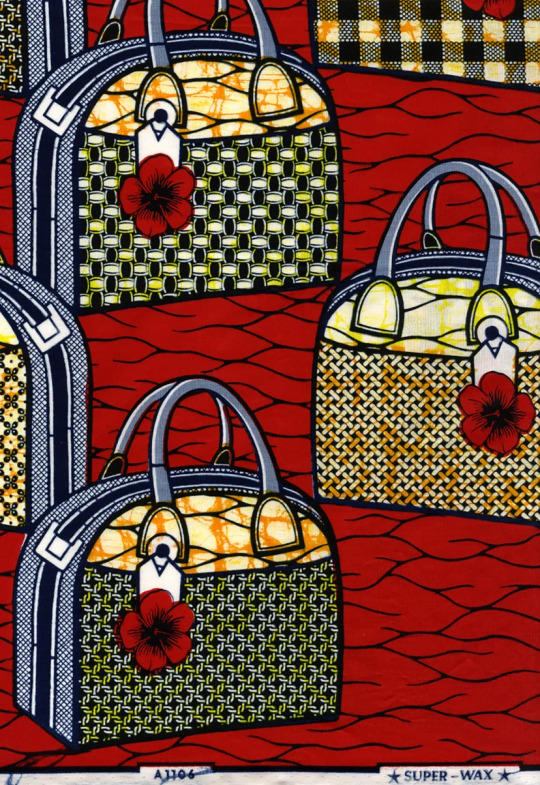
Michelle Obama's Handbag, 2008
Some designs take on famous names. There’s Kofi Annan’s brain, the heart of Barack Obama and this one, named after Michelle Obama when her husband first became the president of the United States, in 2008. The basic appeal translates as: “You cannot afford to be Michelle Obama or buy the same bag as she carries, but because you can buy the pattern on wax print it’s like you’re part of it,” says Grosfilley. Yet, the connection to Obama is accidental. “Vlisco just designed a nice bag but then it’s the African market who said, 'Wow, we should make a connection between Michelle Obama and the bag',” she says. Made from Super Wax, which is softer, thinner and has an extra colour, wearing this more expensive fabric symbolises prestige.
© Vlisco A1106, called “Michelle Obama’s Handbag”, 2008. Holland, Netherlands © Vlisco Group

Violent Eyes, The Mouth Says Nothing, 2011
The surrealist shoe with its tongue-like heel and multiple red-varnished toes is a detail of a larger design, created in 2011, in the Netherlands. Called "the eyes see, but the mouth does not speak,” the print is dominated by a huge mouth with a finger against it to say "shush, don’t speak" in the centre with little mouths in the background which also say nothing. “It’s about being an elegant woman and at the same time full of humour,” says Grosfilley. “We are saying, wear something just to see the good side of things.” The quirky design is accentuated by a bright red outline instead of the classic indigo, showing new ways of using the batik technique.
© Vlisco A1315, called “Eyes see, but the mouth does not speak", 2011. Holland Netherlands © Vlisco Group
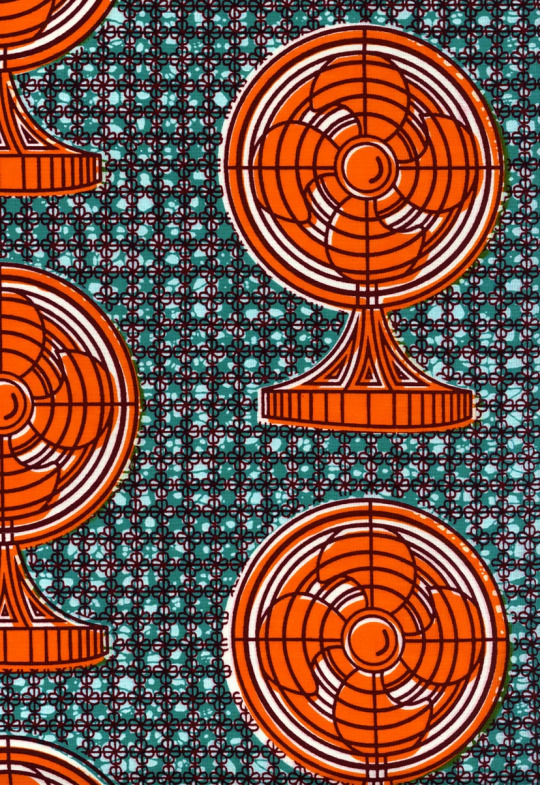
Reproduction Fan Print, 2000s
When electrical fans were introduced to Africa in the 1980s, they appeared on wax print as signs of modernity (as did mobile phones). Now, as fans are only bought by those without air-conditioning, the meaning has changed. “It is casual. You’ve got chairs, table, so what, there’s no point,” the author says. Printed on polycotton from China rather than cotton, bright new colours have been added, like the maroon and yellow and green combo since the original design debuted.
© Wax Mitex 12033307. China.
#fashion#african fashion#vlisco#prints#fashion history#africa#dutch fashion#javanese fashion#java#the netherland
283 notes
·
View notes
Text
Java Program to Print Alphabet Y Star Pattern

User input character. Static star character.
These are the methods for java program to print alphabet Y star pattern.
#Java Program to Print Alphabet Y Star Pattern
0 notes
Text
Basic hello world program in java
Write a java program to print a number from the user
Java program to add two numbers taking input from user
Leap year or not program in java using if-else
Swapping of two numbers in java with temporary variable
Odd or even program in java using a mod operator
Vowel or consonant in java using if else
Java program to find largest of three numbers using nested if
Write a program to print first ten natural numbers in java
Write a program to find factorial of a number using for loop in java
Palindrome string program in java using scanner
Program to check whether the number is prime or not in java
Java program to find Armstrong number using while loop
Java program for a calculator using switch case
Java program to calculate percentage and average
Write a java program to print multiplication table using for loop
Print the sum of the natural numbers program in java using for loop
Write a java program to convert temperature from Fahrenheit to celsius degree
Write a java program to convert temperature from Celsius to Fahrenheit
Java program to find HCF and LCM of two numbers
Java program to print the area of circumference of a circle
Write a java program to print the length and perimeter of a rectangle
Java program to print ASCII value of all alphabets
Java program to print decimal number to binary
Java program to print decimal to octal conversion
Java program to print hexadecimal to decimal number conversion
Octal to hexadecimal conversion program in java
Java program to conversion hexadecimal to decimal number
Java program to print the upper case to lower case alphabets
Java program to print two multiply binary numbers with solution
Java program to find the sum of digits of a number using recursion function
Java program to swap two numbers using bitwise xor operator
Java program to find product of two numbers using recursive function
Write a java program to find the reverse of a given number using recursion
Write a java program to accept two numbers and check which is same or not
Java program to increment by 1 all the digits of a given integer
Java program to print the number positions in list of digits
Write a java program to convert numbers into years, weeks and days
Write a java program to print the ip address
Java program to check whether entered character is uppercase or lowercase
Write a program illustrate use of various boolean operators in java
Java program to print the number entered by the user using for loop
Write a java program to check whether the given number is divisible by 5
Write a java program to take a number and return list of its digits
Java program to print the two digits of the year
Write a java program for atm machine
Java program to find the second biggest and smallest number in the array
Write a java program to sort the names in ascending order
Write a java program to increment every element of the array by one
Java program for banking ticket system using if-else statement
Java program to find which department has highest placement program
Write a java program to find my lucky number or not
Credit score program in java for shop
Java program to count the number of pencils for student
Java program to find numerology number
Java program to calculate uber cost and discount rate
Java program to calculate land price with land area
Java program to calculation the air conditioner capacity for invertor and non invertor
Java program to kindergarten school kids
Java program to calculate cubic capacity cc in bikes
Java program to find the odd or even in the box challenge
Java program to create a login page with username and password
Java code for car parking management system
Java program to find the middle element of the string
Java program to find the cubes of an n natural numbers
Java program to print weekdays using a switch statement
Java program to solve quadratic equation using if-else
Java program calculation to fill the bucket with the water mug
Method Overloading in Java to Find Arithmetic Sum of 2 or 3 or 4 Variables by Passing Argument
Write a java program to print the nested methods to perform mathematical operations
Write a program to concatenate two string in java
How to print semicolon in java program without using it
Write a java program to find the largest number in an array
Write a program to find second largest number in an array in java
Write a java program to find the odd or even number in the array
Write a java program to add element in user-specified position using array
Write a java program to delete an element from an array list at the specified index
Write a java program to arrange strings in alphabetical order
Write a java program to split an array in a specific position
Write a array program to calculate average and sum in java
Write a program to calculate electricity bill in java
Find out duplicate number between 1 to n numbers in java
Program in java to print the pie value(pi)
Java program to print the element using calling methods in the same class
Java program to change the element position in right direction using single dimension array
Write a single dimension array in a java program to modify the element located in the leftwards direction
Write a java program to delete or erase the element in the array in a exact location
Transpose matrix java program in java in a single matrix
Java program to pay and calculate mortgage, loan and insurance payment
Java program to find the length of the array and string a single program
Fibonacci series program in java using recursion and looping statements
Java program to print reverse right-angled triangle of numbers
Pyramid pattern program in java using asterisk
Java program to print mirrored right triangle star pattern
Java program to print the pascal triangle using star
Left triangle using star pattern program in java
Java program to print pyramid pattern of numbers
Program to print the diamond pattern program using numbers in java
Java program to print pascal’s number of rows
Java program to print the triangle pattern program using numbers
Java program to print triangle pattern program using a symbol
Java program to print diamond pattern of numbers
Java program to print a right angle triangle pattern program using for loop
Java program pattern program to triangle using 100 numbers
Write a program to print the down arrow pattern in java
Java pattern programs to print the star in between of the numbers
Java program to print stars and number pyramid in a single pattern program
Java program to print the bubble sort using for loop
Merge sort program in java with output
Quick sort program in java taking first element as pivot
Insertion sort program in java using while loop
Java program to print the heap sort algorithm using for loop
Java program to print the radix sort using while loop
Write a java program to print binary search program using while loop
Java program to print the ascending order using for loop
Descending order program in java using for loop
Java program to print the selection sort using array elements
Write a java program to create a singly linked list and display the element
Write a java program to merge three singly linked list elements
Java program to delete the linked list elements from a singly
Write a java program to count the linked list element in the nodes
0 notes
Photo

Printing Alphabet Rangoli Pattern using Python. Swipe right to see optimized code and output! Rangoli is a form of Indian folk art based on creation of patterns. - - - . . . . . . . . . #python #programming #java #html #javascript #coding #css #programmer #php #code #developer #coder #webdeveloper #software #linux #technology #webdesign #webdevelopment #tech #computerscience #computer #codinglife #softwaredeveloper #development #programmers #android #c #webdesigner https://www.instagram.com/p/Btd9iEmhFe7/?utm_source=ig_tumblr_share&igshid=121u8iq5xjsad
#python#programming#java#html#javascript#coding#css#programmer#php#code#developer#coder#webdeveloper#software#linux#technology#webdesign#webdevelopment#tech#computerscience#computer#codinglife#softwaredeveloper#development#programmers#android#c#webdesigner
0 notes
Text
Print Alphabet Pattern in Java
Alphabet Pattern
In this code you can easily print any alphabet pattern using for loop .
0 notes
Link
Check Floating value
conditions:-> 1. should be a dot or float value [. necessary ] 2. should not enter zero or double zero after dot [ .00 not allow] 3. [.001] is allowed solution:- //checking decimal value after the Dot private fun checkDecimal(userBidPrice: String): Boolean { return if (!Pattern.matches("[+-]?([0-9]+([.][0]*)?|[.][0]+)", userBidPrice)) { if (Pattern.matches("[+-]?([0-9]+([.][1-9]*)?|[.][1-9]+)", userBidPrice)) { true } else Pattern.matches("[+-]?([0-9]+([.][0-9]*)?|[.][1-9]+)", userBidPrice) } else { false } } ___________________________________________________________________ Description About Regular Expression : - Regular Expression Syntax
Problem
You need to learn the syntax of Java regular expressions.
Solution
Consult Table 4-1 for a list of the regular expression characters.
Discussion
These pattern characters let you specify regexes of considerable power. In building patterns, you can use any combination of ordinary text and the metacharacters, or special characters, in Table 4-1. These can all be used in any combination that makes sense. For example, a+ means any number of occurrences of the letter a, from one up to a million or a gazillion. The pattern Mrs?\. matches Mr. or Mrs. And .* means “any character, any number of times,” and is similar in meaning to most command-line interpreters’ meaning of the \* alone. The pattern \d+ means any number of numeric digits. \d{2,3}means a two- or three-digit number.
Table 4-1. Regular expression metacharacter syntax
Subexpression Matches Notes
General
\^
Start of line/string
$
End of line/string
\b
Word boundary
\B
Not a word boundary
\A
Beginning of entire string
\z
End of entire string
\Z
End of entire string (except allowable final line terminator)
See Matching Newlines in Text
.
Any one character (except line terminator)
[…]
“Character class”; any one character from those listed
[\^…]
Any one character not from those listed
See Using regexes in Java: Test for a Pattern
Alternation and Grouping
(…)
Grouping (capture groups)
See Finding the Matching Text
|
Alternation
(?:_re_ )
Noncapturing parenthesis
\G
End of the previous match
\ n
Back-reference to capture group number "n"
Normal (greedy) quantifiers
{ m,n }
quantifiers for “from m to nrepetitions”
See Replacing the Matched Text
{ m ,}
quantifiers for "m or more repetitions”
{ m }
quantifiers for “exactly mrepetitions”
See Program: Apache Logfile Parsing
{,n }
quantifiers for 0 up to nrepetitions
\*
quantifiers for 0 or more repetitions
Short for {0,}
+
quantifiers for 1 or more repetitions
Short for {1,}; see Using regexes in Java: Test for a Pattern
?
quantifiers for 0 or 1 repetitions (i.e, present exactly once, or not at all)
Short for {0,1}
Reluctant (non-greedy) quantifiers
{ m,n }?
Reluctant quantifiers for “from m to nrepetitions”
{ m ,}?
Reluctant quantifiers for "m or more repetitions”
{,n }?
Reluctant quantifiers for 0 up to nrepetitions
\*?
Reluctant quantifiers: 0 or more
+?
Reluctant quantifiers: 1 or more
See Program: Apache Logfile Parsing
??
Reluctant quantifiers: 0 or 1 times
Possessive (very greedy) quantifiers
{ m,n }+
Possessive quantifiers for “from m to nrepetitions”
{ m ,}+
Possessive quantifiers for "m or more repetitions”
{,n }+
Possessive quantifiers for 0 up to nrepetitions
\*+
Possessive quantifiers: 0 or more
++
Possessive quantifiers: 1 or more
?+
Possessive quantifiers: 0 or 1 times
Escapes and shorthands
\
Escape (quote) character: turns most metacharacters off; turns subsequent alphabetic into metacharacters
\Q
Escape (quote) all characters up to \E
\E
Ends quoting begun with \Q
\t
Tab character
\r
Return (carriage return) character
\n
Newline character
See Matching Newlines in Text
\f
Form feed
\w
Character in a word
Use \w+ for a word; see Program: Apache Logfile Parsing
\W
A non-word character
\d
Numeric digit
Use \d+ for an integer; see Using regexes in Java: Test for a Pattern
\D
A non-digit character
\s
Whitespace
Space, tab, etc., as determined by java.lang.Character.isWhitespace( )
\S
A nonwhitespace character
See Program: Apache Logfile Parsing
Unicode blocks (representative samples)
\p{InGreek}
A character in the Greek block
(simple block)
\P{InGreek}
Any character not in the Greek block
\p{Lu}
An uppercase letter
(simple category)
\p{Sc}
A currency symbol
POSIX-style character classes (defined only for US-ASCII)
\p{Alnum}
Alphanumeric characters
[A-Za-z0-9]
\p{Alpha}
Alphabetic characters
[A-Za-z]
\p{ASCII}
Any ASCII character
[\x00-\x7F]
\p{Blank}
Space and tab characters
\p{Space}
Space characters
[ \t\n\x0B\f\r]
\p{Cntrl}
Control characters
[\x00-\x1F\x7F]
\p{Digit}
Numeric digit characters
[0-9]
\p{Graph}
Printable and visible characters (not spaces or control characters)
\p{Print}
Printable characters
\p{Punct}
Punctuation characters
One of !"#$%&'()\*+,-./:;<=>?@[]\^_`{|}\~
\p{Lower}
Lowercase characters
[a-z]
\p{Upper}
Uppercase characters
[A-Z]
\p{XDigit}
Hexadecimal digit characters
[0-9a-fA-F]
0 notes
Text
ls List contents of directories Linux Command
ls
ls [options] [names]
Description
List contents of directories. If no names are given, list the files in the current directory. With one or more names, list files contained in a directory name or that match a file name. names can include filename metacharacters. The options let you display a variety of information in different formats. The most useful options include -F, -R, -l, and -s. Some options don't make sense together (e.g., -u and -c).
Options
-1, --format=single-column Print one entry per line of output. -a, --all List all files, including the normally hidden files whose names begin with a period. -b, --escape Display nonprinting characters in octal and alphabetic format. -c, --time-ctime, --time=status List files by status change time (not creation/modification time). --color =when Colorize the names of files depending on the type of file. Accepted values for when are never, always, or auto. -d, --directory Report only on the directory, not its contents. -f Print directory contents in exactly the order in which they are stored, without attempting to sort them. --full-time List times in full, rather than using the standard abbreviations. -g Long listing like -l, but don't show file owners. -h Print sizes in kilobytes and megabytes. --help Print a help message and then exit. -i, --inode List the inode for each file. --indicator-style=none Display filenames without the flags assigned by -p or -f (default). -k, --kilobytes If file sizes are being listed, print them in kilobytes. This option overrides the environment variable POSIXLY_CORRECT. -l, --format=long, --format=verbose Long format listing (includes permissions, owner, size, modification time, etc.). -m, --format=commas Merge the list into a comma-separated series of names. -n, --numeric-uid-gid Like -l, but use group ID and user ID numbers instead of owner and group names. -o Long listing like -l, but don't show group information. -p, --filetype, --indicator-style=file-type Mark directories by appending / to them. -q, --hide-control-chars Show nonprinting characters as ? (default for display to a terminal). -r, --reverse List files in reverse order (by name or by time). -s, --size Print file size in blocks. --show-control-chars Show nonprinting characters verbatim (default for printing to a file). --si Similar to -h, but uses powers of 1,000 instead of 1,024. -t, --sort=time Sort files according to modification time (newest first). -u, --time=atime, --time=access, --time=use Sort files according to file-access time. --version Print version information on standard output, then exit. -x, --format=across, --format=horizontal List files in rows going across the screen. -v, --sort=version Interpret the digits in names such as file.6 and file.6.1 as versions, and order filenames by version. -w, --width=n Format output to fit n columns. -A, --almost-all List all files, including the normally hidden files whose names begin with a period. Does not include the . and .. directories. -B, --ignore-backups Do not list files ending in ~ unless given as arguments. -C, --format=vertical List files in columns (the default format). -D, --dired List in a format suitable for Emacs dired mode. -F, --classify, --indicator-style=classify Flag filenames by appending / to directories, * to executable files, @ to symbolic links, | to FIFOs, and = to sockets. -G, --no-group In long format, do not display group name. -H, --dereference-command-line When symbolic links are given on the command line, follow the link and list information from the actual file. -I, --ignore pattern Do not list files whose names match the shell pattern pattern, unless they are given on the command line. -L, --dereference List the file or directory referenced by a symbolic link rather than the link itself. -N, --literal Display special graphic characters that appear in filenames. -Q, --quote-name Quote filenames with "; quote nongraphic characters. -R, --recursive List directories and their contents recursively. -Rfile, --reload-state file Load state from file before starting execution. -S, --sort=size Sort by file size, largest to smallest. -U, sort=none Do not sort files. -X, sort=extension Sort by file extension, then by filename.
Example
ls -ltr
Reference : http://ift.tt/2sDE159
from Java Tutorials Corner http://ift.tt/2t2q5Ga via IFTTT
0 notes
Text
25+ Java programs for printing Number, Character Patterns
25+ Java programs for printing Number, Character Patterns
In Java, we can use for loop, while loop or do-while loops to print different number, alphabets or star patterns programs. The following programs demonstrate the same by creating triangle, rectangle or other patterns. Pattern 1 : Printing Floyd’s triangle pattern Floyd’s triangle is a right-angled triangular array of natural numbers. It is named after Robert Floyd. It is defined by filling the…
View On WordPress
#java patterns using for loop#print patterns in java#printing java character patterns#printing java number patterns#printing java star patterns
0 notes
Text
Java Program to Print Alphabet Z Star Pattern

Print Z Star Pattern In Java Number Z = 5 & 4 | 6; Print(Z); Number Z=2^3 Print(Z) Number Z = 5 & 4 6 Print(Z) Number Z=5&4 6 Print(Z) Z Pattern Code Print A To Z In Java etc.
#Java Program to Print Alphabet Z Star Pattern
0 notes
Link
In this code you can easily print any alphabet pattern using for loop .
0 notes
Text
Float Values checking
http://bit.ly/2P4YlZb
Check Floating value
conditions:-> 1. should be a dot or float value [. necessary ] 2. should not enter zero or double zero after dot [ .00 not allow] 3. [.001] is allowed solution:- //checking decimal value after the Dot private fun checkDecimal(userBidPrice: String): Boolean { return if (!Pattern.matches("[+-]?([0-9]+([.][0]*)?|[.][0]+)", userBidPrice)) { if (Pattern.matches("[+-]?([0-9]+([.][1-9]*)?|[.][1-9]+)", userBidPrice)) { true } else Pattern.matches("[+-]?([0-9]+([.][0-9]*)?|[.][1-9]+)", userBidPrice) } else { false } } ___________________________________________________________________ Description About Regular Expression : - Regular Expression Syntax
Problem
You need to learn the syntax of Java regular expressions.
Solution
Consult Table 4-1 for a list of the regular expression characters.
Discussion
These pattern characters let you specify regexes of considerable power. In building patterns, you can use any combination of ordinary text and the metacharacters, or special characters, in Table 4-1. These can all be used in any combination that makes sense. For example, a+ means any number of occurrences of the letter a, from one up to a million or a gazillion. The pattern Mrs?\. matches Mr. or Mrs. And .* means “any character, any number of times,” and is similar in meaning to most command-line interpreters’ meaning of the \* alone. The pattern \d+ means any number of numeric digits. \d{2,3}means a two- or three-digit number.
Table 4-1. Regular expression metacharacter syntax
SubexpressionMatchesNotes
General
\^
Start of line/string
$
End of line/string
\b
Word boundary
\B
Not a word boundary
\A
Beginning of entire string
\z
End of entire string
\Z
End of entire string (except allowable final line terminator)
See Matching Newlines in Text
.
Any one character (except line terminator)
[…]
“Character class”; any one character from those listed
[\^…]
Any one character not from those listed
See Using regexes in Java: Test for a Pattern
Alternation and Grouping
(…)
Grouping (capture groups)
See Finding the Matching Text
|
Alternation
(?:_re_ )
Noncapturing parenthesis
\G
End of the previous match
\ n
Back-reference to capture group number "n"
Normal (greedy) quantifiers
{ m,n }
quantifiers for “from m to nrepetitions”
See Replacing the Matched Text
{ m ,}
quantifiers for "m or more repetitions”
{ m }
quantifiers for “exactly mrepetitions”
See Program: Apache Logfile Parsing
{,n }
quantifiers for 0 up to nrepetitions
\*
quantifiers for 0 or more repetitions
Short for {0,}
+
quantifiers for 1 or more repetitions
Short for {1,}; see Using regexes in Java: Test for a Pattern
?
quantifiers for 0 or 1 repetitions (i.e, present exactly once, or not at all)
Short for {0,1}
Reluctant (non-greedy) quantifiers
{ m,n }?
Reluctant quantifiers for “from m to nrepetitions”
{ m ,}?
Reluctant quantifiers for "m or more repetitions”
{,n }?
Reluctant quantifiers for 0 up to nrepetitions
\*?
Reluctant quantifiers: 0 or more
+?
Reluctant quantifiers: 1 or more
See Program: Apache Logfile Parsing
??
Reluctant quantifiers: 0 or 1 times
Possessive (very greedy) quantifiers
{ m,n }+
Possessive quantifiers for “from m to nrepetitions”
{ m ,}+
Possessive quantifiers for "m or more repetitions”
{,n }+
Possessive quantifiers for 0 up to nrepetitions
\*+
Possessive quantifiers: 0 or more
++
Possessive quantifiers: 1 or more
?+
Possessive quantifiers: 0 or 1 times
Escapes and shorthands
\
Escape (quote) character: turns most metacharacters off; turns subsequent alphabetic into metacharacters
\Q
Escape (quote) all characters up to \E
\E
Ends quoting begun with \Q
\t
Tab character
\r
Return (carriage return) character
\n
Newline character
See Matching Newlines in Text
\f
Form feed
\w
Character in a word
Use \w+ for a word; see Program: Apache Logfile Parsing
\W
A non-word character
\d
Numeric digit
Use \d+ for an integer; see Using regexes in Java: Test for a Pattern
\D
A non-digit character
\s
Whitespace
Space, tab, etc., as determined by java.lang.Character.isWhitespace( )
\S
A nonwhitespace character
See Program: Apache Logfile Parsing
Unicode blocks (representative samples)
\p{InGreek}
A character in the Greek block
(simple block)
\P{InGreek}
Any character not in the Greek block
\p{Lu}
An uppercase letter
(simple category)
\p{Sc}
A currency symbol
POSIX-style character classes (defined only for US-ASCII)
\p{Alnum}
Alphanumeric characters
[A-Za-z0-9]
\p{Alpha}
Alphabetic characters
[A-Za-z]
\p{ASCII}
Any ASCII character
[\x00-\x7F]
\p{Blank}
Space and tab characters
\p{Space}
Space characters
[ \t\n\x0B\f\r]
\p{Cntrl}
Control characters
[\x00-\x1F\x7F]
\p{Digit}
Numeric digit characters
[0-9]
\p{Graph}
Printable and visible characters (not spaces or control characters)
\p{Print}
Printable characters
\p{Punct}
Punctuation characters
One of !"#$%&'()\*+,-./:;<=>?@[]\^_`{|}\~
\p{Lower}
Lowercase characters
[a-z]
\p{Upper}
Uppercase characters
[A-Z]
\p{XDigit}
Hexadecimal digit characters
[0-9a-fA-F]
via Blogger http://bit.ly/2v2Ynrn
0 notes
Text
10+ Java Letter / Character Pattern Programs
10+ Java Letter / Character Pattern Programs
In Java, we can use for loop, while loop or do-while loops to print different number, alphabet or star patterns programs. Here are some examples for character or letter pattern programs. For other patterns, please refer the links at the end of the post. Character Pattern Program 1: A BC DEF GHIJ KLMNO class CharPattern1 { public static void main(String[] args) { char ch = 'A'; for (int i = 1; i…
View On WordPress
#alphabet pattern printing in java#alphabet patterns in java#character pattern programs#character patterns in java#diamond letter program in java#difficult pattern programs in java#how to print character in pattern java#java Character Pattern Programs#Java letter pattern programs#java letter pattern programs examples#java patterns using for loop#java program for patterns#java program to print the following pattern#java programs for patterns#java triangle pattern programs#letter pattern in java#letter pattern programs#letter pattern programs in java#letter pattern programs in java using for loop#letter patterns in java#letter pattrns in java#letter program patten in java#pattern java program#pattern printing in java#pattern program in java#pattern program using for loop in java#pattern programs in java#pattern programs in java using for loop#print patterns in java#printing java character patterns
0 notes